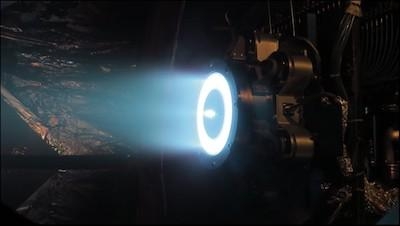Thu, Nov 14, 2019
Full Power Demonstration Conducted On The Hall Thruster
NASA and Aerojet Rocketdyne recently demonstrated an Advanced Electric Propulsion System (AEPS) thruster at full power for the first time, achieving an important program milestone. Aerojet Rocketdyne-developed AEPS thrusters are slated to be used on the Power and Propulsion Element of NASA’s Gateway, the agency’s orbiting lunar outpost for robotic and human exploration operations in deep space.

The state-of-the-art AEPS Hall thruster operated at 12.5 kilowatts (kW) as part of its final conditioning sequence during testing at the Jet Propulsion Laboratory in Pasadena, California. The thruster demonstrated stable operation at power levels ranging from 4.2 kW to 12.5 kW. Full electric propulsion thruster string integration will take place early next year.
“Our AEPS thruster has demonstrated the high levels of power needed to operate the Power and Propulsion Element, and by extension, the entire Gateway,” said Aerojet Rocketdyne CEO and President Eileen Drake. “With a successful full power test complete, Aerojet Rocketdyne is ready for the next phase of our advanced electric propulsion system in support of NASA’s Artemis program.”
The Gateway’s Power and Propulsion Element is a high-power solar electric propulsion spacecraft capable of producing 60 kW – which is three times more powerful than current capabilities. Two Aerojet Rocketdyne AEPS thruster strings will be employed on the spacecraft. Each string is comprised of a Xenon Hall thruster, a power processing unit that controls the electric power to the thruster, and a Xenon flow controller which controls the flow of Xenon to the thruster.
The AEPS thruster is part of a larger Aerojet Rocketdyne AEPS development effort under contract with NASA’s Glenn Research Center. Early system integration tests for AEPS were successfully conducted last August, proving the system’s ability to successfully convert power at a high efficiency level, producing minimal waste heat. NASA aims to launch the Power and Propulsion Element in late 2022 in support of the Artemis program, which will land the first woman and next man on the Moon by 2024.
(Image provided with Aerojet Rocketdyne news release)
More News
Also: Vertical Flight Society, NBAA Maintenance Conference, GA Honored, AMT Scholarship For the first time, students from Embry-Riddle’s Daytona Beach, Florida, campus took t>[...]
Hazardous Weather Information Summary of significant meteorological information (SIGMET/WS), convective significant meteorological information (convective SIGMET/WST), urgent pilot>[...]
"The need for innovation at speed and scale is greater than ever. The X-62A VISTA is a crucial platform in our efforts to develop, test and integrate AI, as well as to establish AI>[...]
(FAA) Inspector Observed That Both Fuel Tanks Were Intact And That Only A Minimal Amount Of Fuel Remained In Each Analysis: According to the pilot, approximately 8 miles from the d>[...]
“Pyka’s Pelican Cargo is unlike any other UAS solution on the market for contested logistics. We assessed a number of leading capabilities and concluded that the Pelica>[...]
 Airborne-Flight Training 05.09.24: ERAU at AIAA, LIFT Diamond Buy, Epic A&P
Airborne-Flight Training 05.09.24: ERAU at AIAA, LIFT Diamond Buy, Epic A&P ANN's Daily Aero-Term (05.07.24): Hazardous Weather Information
ANN's Daily Aero-Term (05.07.24): Hazardous Weather Information Aero-News: Quote of the Day (05.07.24)
Aero-News: Quote of the Day (05.07.24) NTSB Final Report: Cessna 150
NTSB Final Report: Cessna 150 Aero-News: Quote of the Day (05.08.24)
Aero-News: Quote of the Day (05.08.24)



